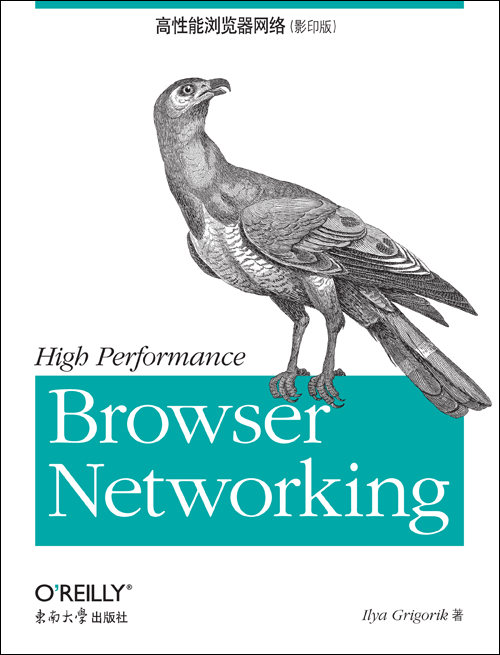高性能浏览器网络(影印版)
出版时间:2014年06月
页数:408
“任何希望了解Web性能的人都有必要阅读此书,它是一本可以直接拿来使用的关于这一主题的参考书。”
——Mark Nottingham,IETF HTTPbis工作组主席
你为搭建快速而又高效的Web应用做了多少准备?从可能影响性能的基础架构局限性到搭建更强大浏览器应用的诸多创新技术——包括HTTP 2.0和XHR改进、服务器发送事件(SSE)、WebSocket以及WebRTC,这本具有说服力的书籍为每一名Web开发人员提供了其所应该了解的关于网络的方方面面。
作为一名Google的Web性能工程师,作者Ilya Grigorik展示了针对TCP、UDP和TLS协议的性能优化最佳实践,他还解释了无线和移动网络优化特有的需求。接下来你会深入了解各种技术的性能特性,包括HTTP 2.0、基于XHR的客户端网络脚本、基于SSE和WebSocket的实时数据流以及基于WebRTC的P2P通信。
· 交付优化的TCP、UDP和TLS性能
· 在3G/4G移动网络上优化网络性能
· 开发快速而又低能耗的移动应用
· 讲解在HTTP 1.x和其他浏览器协议中的瓶颈
· 规划和交付最佳的HTTP 2.0性能
· 在浏览器中激活高效的实时数据流
· 使用实时WebRTC传输技术创建高效的点对点视频会议和低延时应用
Ilya Grigorik是一名Google公司的Web性能工程师和开发人员,他主要负责通过搭建和推动采用Google内外部的性能最佳实践来使得Web访问更为迅速。
——Mark Nottingham,IETF HTTPbis工作组主席
你为搭建快速而又高效的Web应用做了多少准备?从可能影响性能的基础架构局限性到搭建更强大浏览器应用的诸多创新技术——包括HTTP 2.0和XHR改进、服务器发送事件(SSE)、WebSocket以及WebRTC,这本具有说服力的书籍为每一名Web开发人员提供了其所应该了解的关于网络的方方面面。
作为一名Google的Web性能工程师,作者Ilya Grigorik展示了针对TCP、UDP和TLS协议的性能优化最佳实践,他还解释了无线和移动网络优化特有的需求。接下来你会深入了解各种技术的性能特性,包括HTTP 2.0、基于XHR的客户端网络脚本、基于SSE和WebSocket的实时数据流以及基于WebRTC的P2P通信。
· 交付优化的TCP、UDP和TLS性能
· 在3G/4G移动网络上优化网络性能
· 开发快速而又低能耗的移动应用
· 讲解在HTTP 1.x和其他浏览器协议中的瓶颈
· 规划和交付最佳的HTTP 2.0性能
· 在浏览器中激活高效的实时数据流
· 使用实时WebRTC传输技术创建高效的点对点视频会议和低延时应用
Ilya Grigorik是一名Google公司的Web性能工程师和开发人员,他主要负责通过搭建和推动采用Google内外部的性能最佳实践来使得Web访问更为迅速。
- Networking 101
- Chapter 1: Primer on Latency and Bandwidth
- Speed Is a Feature
- The Many Components of Latency
- Speed of Light and Propagation Latency
- Last-Mile Latency
- Bandwidth in Core Networks
- Bandwidth at the Network Edge
- Delivering Higher Bandwidth and Lower Latencies
- Chapter 2: Building Blocks of TCP
- Three-Way Handshake
- Congestion Avoidance and Control
- Bandwidth-Delay Product
- Head-of-Line Blocking
- Optimizing for TCP
- Chapter 3: Building Blocks of UDP
- Null Protocol Services
- UDP and Network Address Translators
- Optimizing for UDP
- Chapter 4: Transport Layer Security (TLS)
- Encryption, Authentication, and Integrity
- TLS Handshake
- TLS Session Resumption
- Chain of Trust and Certificate Authorities
- Certificate Revocation
- TLS Record Protocol
- Optimizing for TLS
- Performance Checklist
- Testing and Verification
- Performance of Wireless Networks
- Chapter 5: Introduction to Wireless Networks
- Ubiquitous Connectivity
- Types of Wireless Networks
- Performance Fundamentals of Wireless Networks
- Measuring Real-World Wireless Performance
- Chapter 6: WiFi
- From Ethernet to a Wireless LAN
- WiFi Standards and Features
- Measuring and Optimizing WiFi Performance
- Optimizing for WiFi Networks
- Chapter 7: Mobile Networks
- Brief History of the G’s
- Device Features and Capabilities
- Radio Resource Controller (RRC)
- End-to-End Carrier Architecture
- Packet Flow in a Mobile Network
- Heterogeneous Networks (HetNets)
- Real-World 3G, 4G, and WiFi Performance
- Chapter 8: Optimizing for Mobile Networks
- Preserve Battery Power
- Eliminate Periodic and Inefficient Data Transfers
- Anticipate Network Latency Overhead
- Design for Variable Network Interface Availability
- Burst Your Data and Return to Idle
- Offload to WiFi Networks
- Apply Protocol and Application Best Practices
- HTTP
- Chapter 9: Brief History of HTTP
- HTTP 0.9: The One-Line Protocol
- HTTP 1.0: Rapid Growth and Informational RFC
- HTTP 1.1: Internet Standard
- HTTP 2.0: Improving Transport Performance
- Chapter 10: Primer on Web Performance
- Hypertext, Web Pages, and Web Applications
- Anatomy of a Modern Web Application
- Performance Pillars: Computing, Rendering, Networking
- Synthetic and Real-User Performance Measurement
- Browser Optimization
- Chapter 11: HTTP 1.X
- Benefits of Keepalive Connections
- HTTP Pipelining
- Using Multiple TCP Connections
- Domain Sharding
- Measuring and Controlling Protocol Overhead
- Concatenation and Spriting
- Resource Inlining
- Chapter 12: HTTP 2.0
- History and Relationship to SPDY
- The Road to HTTP 2.0
- Design and Technical Goals
- Brief Introduction to Binary Framing
- Chapter 13: Optimizing Application Delivery
- Evergreen Performance Best Practices
- Optimizing for HTTP 1.x
- Optimizing for HTTP 2.0
- Browser APIs and Protocols
- Chapter 14: Primer on Browser Networking
- Connection Management and Optimization
- Network Security and Sandboxing
- Resource and Client State Caching
- Application APIs and Protocols
- Chapter 15: XMLHttpRequest
- Brief History of XHR
- Cross-Origin Resource Sharing (CORS)
- Downloading Data with XHR
- Uploading Data with XHR
- Monitoring Download and Upload Progress
- Streaming Data with XHR
- Real-Time Notifications and Delivery
- XHR Use Cases and Performance
- Chapter 16: Server-Sent Events (SSE)
- EventSource API
- Event Stream Protocol
- SSE Use Cases and Performance
- Chapter 17: WebSocket
- WebSocket API
- WebSocket Protocol
- WebSocket Use Cases and Performance
- Performance Checklist
- Chapter 18: WebRTC
- Standards and Development of WebRTC
- Audio and Video Engines
- Real-Time Network Transports
- Establishing a Peer-to-Peer Connection
- Delivering Media and Application Data
- DataChannel
- WebRTC Use Cases and Performance
- Performance Checklist
- Index
- Colophon
书名:高性能浏览器网络(影印版)
作者:Ilya Grigorik 著
国内出版社:东南大学出版社
出版时间:2014年06月
页数:408
书号:978-7-5641-4961-1
原版书书名:High Performance Browser Networking
原版书出版商:O'Reilly Media
购买选项
